
 |
||||||
Information identified as archived is provided for reference, research or recordkeeping purposes. It is not subject to the Government of Canada Web Standards and has not been altered or updated since it was archived. Please "contact us" to request a format other than those available.

|
Students in the labour marketJeannine Usalcas and Geoff BowlbyLabour Force Survey Statistics Canada Statistics Canada gratefully acknowledges the financial support of the Canadian Council on Learning for the analysis presented in this article. Introduction IntroductionCanada's 2.4 million full-time students are an important part of the national workforce.Over the last eight years, employers have increasingly turned to students to find the workers they need. During the 2004-2005 school year, 939,000 full-time students, or close to four out of every ten (38.9%) full-time students between the ages of 15 and 24, were combining school and work. This is an increase of seven percentage points over the 1997-1998 school year. Nearly half (45.9%) of all students aged 18 to 24 years and 31.2% of younger students aged 15 and 17 were employed in 2004-2005. While job availability has improved in recent years, the share of 15 to 24 year-old full-time students who are working is still lower than it was in 1989, the previous peak employment period. Younger students (aged 15 to 17) are much less likely to be working while attending school than they were a decade and a half ago. Furthermore, the summer job market has not improved to the same extent as it has during the school year. Approximately 51.7% of students were employed during the summer of 2005, well below the percentage of 61.4% in 1989. Students have a variety of motivations for seeking employment. According to the Youth in Transition Survey (Cycle 1-2000), younger teens are likely to work for discretionary income, to buy the things they want. Data from the 2002 Postsecondary Education Participation Survey (PEPS), however, show that 18 to 24 year olds rely on their earnings to help fund their studies.Recent analysis of the PEPS data shows that in 2001-2002, income from employment held during the 2001-2002 academic year was the second most commonly used source of postsecondary funding for full-time students aged 18 to 24 years (17 to 24 in Quebec), reported by 63% of students.1 In fact, based on dollar amounts, these were the largest sources of funds for postsecondary studies reported by students in the 2002 PEPS (money from personal savings was more commonly used – by more than three-quarters of students – but accounted for a smaller proportion of total funds). Nevertheless, the results show that personal savings and current employment income generally were inadequate to cover the costs of tuition, books and supplies for postsecondary students, with most of them reporting drawing on a variety of other financial sources to supplement the funds they had at their disposal from their savings and employment income. In addition to funds for their education and to satisfy their consumer desires, students also want experience in the labour force that will enable them to show employers that they possess the background knowledge, attitudes, and prior experience necessary for full time work, helping to break the cycle of "no experience, no job; no job, no experience."This article uses data from the Labour Force Survey to examine trends in the labour market experiences of young men and women who are full-time students: younger students aged 15 to 17 years (of normal high school age) and older students aged 18 to 24 years old (a typical age for attending postsecondary institutions). The analysis distinguishes between employment during the school year (September to April) and employment during the summer months. Combining school and work - the large gap between young teens and older students remainsPrior to 1990, employment rates for 15 to 17 year-olds and for 18 to 24 year-olds were quite similar. But, beginning with the recession of the early 1990s, the employment patterns for the two groups began to diverge. The recession affected 15 to 17 year-olds more strongly than their older counterparts. Employment rates for the younger age group declined 16.0 percentage points between 1989-1990 and 1997-1998; at 3.9 percentage points, the decline was much less pronounced for 18 to 24 year-olds. This created an employment gap between younger and older students that remains today.The economic recovery in the latter half of the 1990s sparked employment gains for students. Employment rates in 2004-2005 reached 38.9% for full-time students aged 15 to 24 years, an increase of seven percentage points from the 1997-1998 school year when student employment first began to increase. Despite the increase, the employment rate for full-time students is still below the peak reached in 1989-1990 (41.7%). Today, students of all ages are more likely to be working than they were in 1997-1998, but the gap that emerged during the early 1990s recession remains. Older students are much more likely to work than younger students during the school year -- approximately 46.0% of students between the ages of 18 and 24 worked during the 2004-2005 school year, compared with 31.2% of students between 15 and 17 years of age (Figure 1). In fact, students 18 to 24 years-old have never been more actively engaged in the labour market during the school year. On the other hand, younger students remain well below their peak rate of employment of 40.8% in 1989-1990.Figure 1: Employment rate during the school year, full-time students, by age group, Canada, 1976-1977 to 2004-2005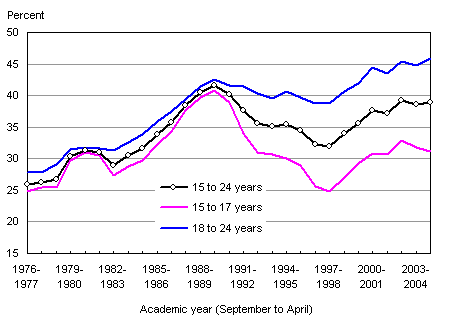 Source: Labour Force Survey, Statistics Canada It is difficult to know whether the difference between the two age groups reflects a preference on the part of younger students to choose not to work in order to spend the time on school studies and activities or whether the difference reflects a scarcity of opportunities available to younger workers. It appears that school workload plays a role in the decision to work or not. For example, the 2002 Youth in Transition Survey asked seventeen year-olds to identify the main reason they were not working at a job during the previous year of high school. The majority said that they had chosen to focus on schoolwork or activities instead of seeking paid employment. Combining school and work - female students are much more likely to be workingAn employment rate gap also exists between male and female students during the school year. Female students have traditionally been more likely to combine work and school than male students. However, the gender gap has never been greater.In the 2004-2005 school year, 34.3% of female students aged 15 to 17 were working, much higher than the 28.2% of males of the same age (Table 1). The gender gap was even greater among older students; about one half of female students aged 18 to 24 years (50.5%) were working compared to two of every five male students (40.7%), a record 9.8 percentage-point gap (Figure 2A and 2B). The growing gender gap in employment may reflect employment growth in retail trade and accommodation and food services, sectors of the economy in which women are more likely to take on jobs as cashiers, salespersons, or food and beverage servers.2 Figure 2a: Employment rate during the school year, full-time students aged 15 to 17, by gender, Canada, 1976-1977 to 2004-2005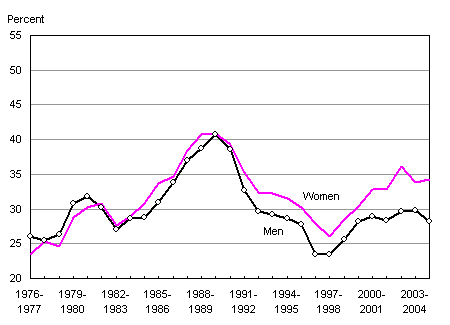
Figure 2b: Employment rate during the school year, full-time students aged 18 to 24, by gender, Canada, 1976-1977 to 2004-2005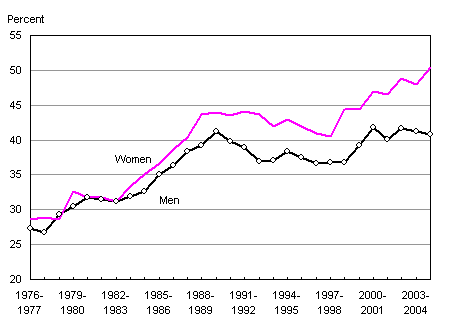 Source: Labour Force Survey, Statistics Canada Where did full-time students work during the school year?Students are mainly employed in two sectors of the economy: retail and wholesale trade, and accommodation and food services. These two sectors, combined, employed six in ten working students during the 2004-2005 school year, many more than than the one in three non-students aged 15 to 24 (36%) employed in these sectors. Although these sectors of the economy offer students the flexibility to combine schooling with part-time employment, they also often offer lower pay and less employment security.Employment growth for students has been greatest in wholesale and retail trade over the last eight school years. In 2004-2005, 36.8% of employed students were working in this sector, compared with 31.6% in 1997-1998. The vast majority of the jobs in this sector were in grocery, health and personal care, clothing, and in stores selling general merchandise. The rate of employment growth in this sector was greater for younger students and women than it was for older students and males. Over the past eight school years, employment for students grew modestly in accommodation and food services. Most of that growth was in the food services industry (mainly in restaurants) and took place between the 1999-2000 to 2001-2002 school years, with little growth since. The share of full-time students working in this sector has not changed since 1997-1998, remaining at 24% in 2004-2005. Employment gains in this sector were stronger for younger than for older students.A growing number of students are finding work in two other economic sectors: information, culture and recreation; and educational services. In 2004-2005, 8.0% of students worked in information, culture and recreation, compared to 6.8% in 1997-1998. Female students in both age categories were the main beneficiaries of employment growth in this sector. Most of the new jobs were in recreation and sports facilities such as fitness and recreational sports centres, golf courses, bowling and skiing facilities. Older students were more likely to find jobs in educational services, where 7.9% of 18 to 24 year-old students were employed in 2004-2005. This is an increase from the 6.9% working in this sector in 1997-1998. Most of these students were employed as teaching or research assistants in universities.The summer job marketSummer employment for students has improved only moderately over the past eight years. Employment rates in the summer of 2005 averaged 51.7% for students planning to return to their studies in the fall, compared to 46.9% in the summer of 1998, and remains far from the peak reached in the summer of 1989 when 61.4% of students were employed (Table 2).For many students, summer jobs represent an extension of hours from positions held during the school year. During the summer months, however, students are also more likely to be working in the goods-producing sector, especially in manufacturing, construction and agriculture. Although gains were not strong, summer employment opportunities have nevertheless improved for both younger and older students (Figure 3). As with employment during the school year, females have been the main beneficiaries of summer employment growth. Prior to the recession of the 1990s, male full-time students were more likely than female students to be employed during the summer months. The recession of the early 1990s affected male students more than female students and the recovery has been weaker for male students. As a result, female full-time students are now much more likely than their male counterparts to be employed during the summer months. Compared to the summer of 1998, employment rates for female students increased 7.1 percentage points, reaching 55.2% in the summer of 2005; this compares to a 2.2 percentage point increase for male students over the same period, with the employment rate rising to 47.9% in 2005 (Figure 4).Figure 3: Summer employment rates, returning full-time students, by age group, Canada, 1977 to 2005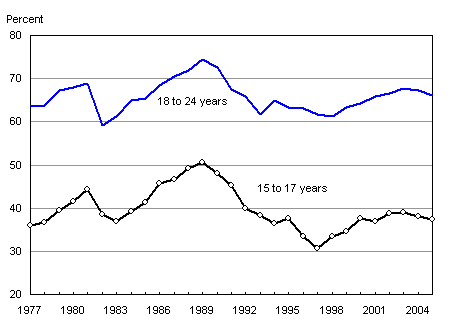 Source: Labour Force Survey, Statistics Canada Figure 4: Summer employment rates, returning full-time students, by gender, Canada, 1977 to 2005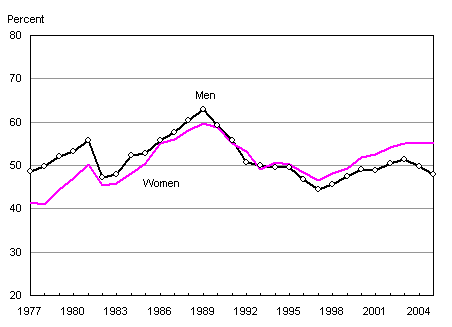 Source: Labour Force Survey, Statistics Canada Between 1998 and 2003, overall employment increased during the summer months; however, employment rates remained flat in the summers of 2004 and 2005 for female students, while male students experienced declines. Male students lost jobs and saw their employment rate decrease from 51.5% in the summer of 2003 to 47.9% in 2005. There were declines for male students in several industries, but the largest decreases were in accommodation and food services, information, culture and recreation, as well as trade. Over the longer term, it would appear that the diminishing employment role of the goods-producing sector in Canada has had an impact on summer employment among male full-time students. Compared to the summer of 1989, more male full-time students were working in the services sector in the summer of 2005: in finance, insurance, real estate and leasing; professional, scientific and technical services; business, building and other support services; educational services; information, culture and recreation; and accommodation and food services. Fewer were working in agriculture, construction and manufacturing.Hours of work during the school year and during the summerStudents are working longer hours during the school year than ever before. The average number of hours students dedicate to work per week has increased over the last eight school years. In 2004-2005, student employees spent an average of 15.3 hours a week at their main job compared to 13-to-14 hours a week in the 1980s and 1990s (Table 3).From one point of view, more hours worked means more money for young people. On the other hand, studies conducted in the 1990s show that working too many hours while in school can have negative consequences for full-time students, especially young teens. The evidence shows that working 20 or more hours per week while still attending school full-time can increase stress levels, affect academic achievement, and increase absenteeism and the risk of dropping out.3, 4, 5 Younger students spend less time working than older students during the school year, working an average of 13.3 hours per week in 2004-2005 compared to an average of 16.5 hours per week for 18 to 24 year-olds. Male students worked an average of almost one hour more per week (15.7 hours in 2004-2005) than female students (15.0 hours).Although students are working longer hours than ever during the school year, in recent years there has been no change in the hours worked during the summer months. In the summer of 2005, students worked an average of 25.3 hours a week. This average is unchanged from the summer of 1998 and continues to be lower than the average number of summer hours worked three decades ago. In the summer of 1977, full-time students worked an average of 30 hours a week. Student wagesDuring the 2004-2005 school year, the average hourly wage for a full-time student aged 15 to 24 years was $8.95. Students aged 18 to 24 years earned more ($9.60/hour) than students aged 15 to 17 ($7.82/hour) (Table 4). Hourly wages for younger students closely resemble minimum wage rates which vary by province, ranging from $6.00 to $8.00 per hour in 2005.Average hourly wages have not increased for students over the last eight school years, though the trends have been different for the two age groups. After adjusting for inflation, hourly wages have actually decreased for 15 to 17 year-olds since 1997-1998 (down 1.8%) and increased for older students (up 2.1%). Weekly wages during the school year have increased over time because the average number of hours students work has increased. In 2004-2005, students worked an average of one hour more than their counterparts in 1997-1998, increasing their weekly wages by 6.4% over this period to $139.06 (adjusted for inflation). Older students made more at $160.27 compared to the weekly wage of $102.62 for 15 to 17 year-olds.In the summer of 2005, 15 to 24 year-old students made an average of $246.84 a week, an increase of 2% from the summer of 1998 (adjusted for inflation) (Table 5). Because older students were better paid and worked longer hours, they earned more than younger students. Older students earned an average of $294.98 per week during the summer of 2005, while younger students earned an average of $157.37. Alberta is best for jobs during the school year and PEI during the summer monthsIt is not surprising that when there are more job opportunities, there are more students combining school and work. For example, in booming Alberta, 44.3% of full-time students were employed during the 2004-2005 school year, compared to 23.0% in Newfoundland and Labrador (Table 6). The Prairie provinces, Quebec and Ontario had student employment rates above the national average in 2004-2005. All provinces experienced employment rate increases among full-time students between 1997-1998 and 2004-2005, but Quebec (increasing from 26.4% to 39.8%) and New Brunswick (increasing from 20.9% to 32.9%) saw the largest changes (Figure 5).During the summer months, Prince Edward Island topped all provincial labour markets. In the summer of 2005, 67.1% of full-time students were employed, largely due to the number of summer tourism and agricultural jobs available there (Table 7). The Prairie provinces, as well as Nova Scotia and New Brunswick, followed closely behind. However, in Canada's three largest provinces (Ontario, Quebec, and British Columbia), employment rates for full-time students in the summer of 2005 were at or below the national average (Figure 6). In all provinces, summer employment was most common in trade, accommodation and food services, followed by information, culture and recreation. But some provinces had higher-than-average percentages of students working in certain industries during the summer of 2005. For example, Prince Edward Island, British Columbia, Manitoba and New Brunswick had higher numbers of students employed in accommodation and food services than other provinces. Quebec had the highest proportion of students working in trade, while Ontario, Quebec and British Columbia had higher proportions of students working in manufacturing.Figure 5: Employment rates during the school year, full-time students, by province, 1997-1998 and 2004-2005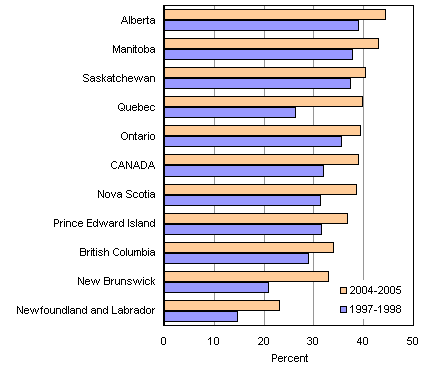 Source: Labour Force Survey, Statistics Canada Figure 6: Employment rates during the summer months, returning full-time students, by province, 1998 and 2005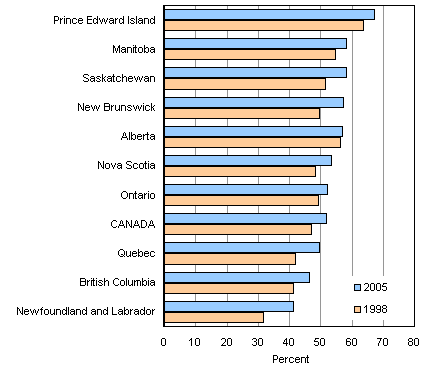 Source: Labour Force Survey, Statistics Canada Summary and conclusionAlthough student employment has increased considerably in recent years, the share of full-time students combining school and work remains below the peak attained during the 1989-1990 school year. However, this recent change in average youth employment masks a divergence between older and younger students. A higher proportion of 18 to 24 year-old students are working now than ever before, having reached a peak employment rate of 45.9% in 2004-2005. Younger students, however, are much less likely to be working now than during the previous peak employment period of 1989-1990.Female students of all ages benefitted more from the recent employment gains than did their male counterparts. This is likely due to increased employment opportunities in retail trade and accommodation and food services, sectors in which women are more likely to take on jobs as cashiers, salespersons and food servers. While combining school and work during the school year has become increasingly common, the summer job market has only moderately improved over the last eight years. Summer student employment growth has been especially weak for male students. Compared to the summer 1989 when employment rates for male students were at their peak, there were far fewer jobs available in the summer of 2005 in the more male-dominated sectors of manufacturing, construction, and agriculture.Once adjusted for inflation, average hourly wages for full-time students who had jobs during the school year were unchanged over the last eight years. But, because students worked an average of one hour a week more during the 2004-2005 school year than they did in 1997-1998, their total weekly wages increased. During the summer months of 2005, younger students were paid less and were working fewer hours than they did in 1998. This is likely because younger students tended to find job opportunities in retail trade and accommodation and food services, sectors of the economy where wages tend to be lower. On the other hand, older students earned more during the summer of 2005 than they did eight years earlier because of longer periods of work and higher base pay on average.Full-time students in Alberta, the Prairie provinces and Quebec were most likely to be employed during the school year in 2005. Employers in Prince Edward Island provided more jobs to students in the summer months, followed by the Prairie provinces, New Brunswick and Nova Scotia. Employment during the school year and during the summer months represents a key source of funding for postsecondary students. Given the importance of personal savings for such funding, it can also be expected that younger students aged 15 to 17 years old may also be setting aside savings in anticipation of pursuing postsecondary studies.A healthy student job market that provides both job opportunities and decent earnings prospects is critically important to young people. Their earnings allow them to pursue postsecondary studies and the working experience they gain helps give them the experience and skills they need to ensure a smoother transition into the workforce once they complete their studies. But there has been little improvement in the student job market over the past few years. Postsecondary education costs are rising and the evidence suggests that, for many students, their personal savings and earnings during the school year are insufficient to cover the costs of tuition, books and supplies. This raises questions around the affordability of postsecondary education for many students, the extent to which alternative sources of funding are available to them, and to what extent a strong student labour market can play a role in helping them to pay for their postsecondary education. Notes
Source: Statistics Canada, Labour Force Survey.
Source: Statistics Canada, Labour Force Survey.
|
|